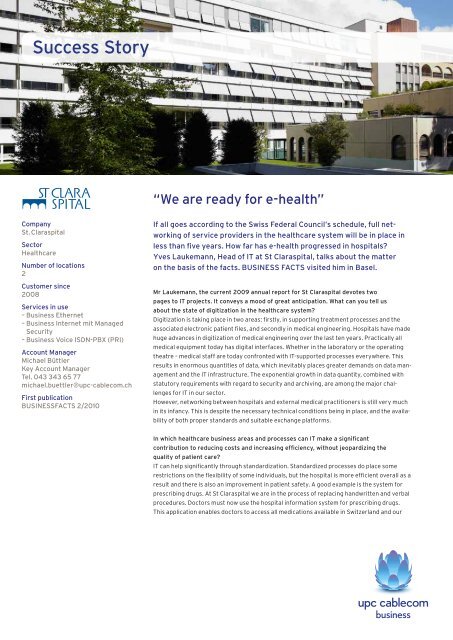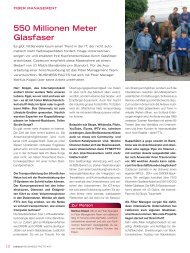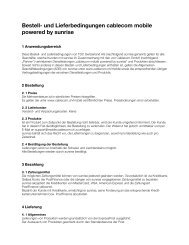Yves Laukemann - upc cablecom business
Yves Laukemann - upc cablecom business
Yves Laukemann - upc cablecom business
You also want an ePaper? Increase the reach of your titles
YUMPU automatically turns print PDFs into web optimized ePapers that Google loves.
Success Story<br />
“We are ready for e-health”<br />
Company<br />
St. Claraspital<br />
Sector<br />
Healthcare<br />
Number of locations<br />
2<br />
Customer since<br />
2008<br />
Services in use<br />
– Business Ethernet<br />
– Business Internet mit Managed<br />
Security<br />
– Business Voice ISDN-PBX (PRI)<br />
Account Manager<br />
Michael Büttler<br />
Key Account Manager<br />
Tel. 043 343 65 77<br />
michael.buettler@<strong>upc</strong>-<strong>cablecom</strong>.ch<br />
First publication<br />
BusinessFacts 2/2010<br />
If all goes according to the Swiss Federal Council’s schedule, full networking<br />
of service providers in the healthcare system will be in place in<br />
less than five years. How far has e-health progressed in hospitals?<br />
<strong>Yves</strong> <strong>Laukemann</strong>, Head of IT at St Claraspital, talks about the matter<br />
on the basis of the facts. BUSINESS FACTS visited him in Basel.<br />
Mr <strong>Laukemann</strong>, the current 2009 annual report for St Claraspital devotes two<br />
pages to IT projects. It conveys a mood of great anticipation. What can you tell us<br />
about the state of digitization in the healthcare system?<br />
Digitization is taking place in two areas: firstly, in supporting treatment processes and the<br />
associated electronic patient files, and secondly in medical engineering. Hospitals have made<br />
huge advances in digitization of medical engineering over the last ten years. Practically all<br />
medical equipment today has digital interfaces. Whether in the laboratory or the operating<br />
theatre – medical staff are today confronted with IT-supported processes everywhere. This<br />
results in enormous quantities of data, which inevitably places greater demands on data management<br />
and the IT infrastructure. The exponential growth in data quantity, combined with<br />
statutory requirements with regard to security and archiving, are among the major challenges<br />
for IT in our sector.<br />
However, networking between hospitals and external medical practitioners is still very much<br />
in its infancy. This is despite the necessary technical conditions being in place, and the availability<br />
of both proper standards and suitable exchange platforms.<br />
In which healthcare <strong>business</strong> areas and processes can IT make a significant<br />
contribution to reducing costs and increasing efficiency, without jeopardizing the<br />
quality of patient care?<br />
IT can help significantly through standardization. Standardized processes do place some<br />
restrictions on the flexibility of some individuals, but the hospital is more efficient overall as a<br />
result and there is also an improvement in patient safety. A good example is the system for<br />
prescribing drugs. At St Claraspital we are in the process of replacing handwritten and verbal<br />
procedures. Doctors must now use the hospital information system for prescribing drugs.<br />
This application enables doctors to access all medications available in Switzerland and our
Profile<br />
hospital catalogue with around 1,300 medications. The system also provides doctors with<br />
important information about the interactions of medications. The new process standardizes<br />
the communication between doctors, nurses and pharmacists, creates the necessary transparency<br />
for optimum inventory management, and above all benefits patients. This is because<br />
the new medication management system guarantees that the right medication is prescribed<br />
at the right time.<br />
IT also helps significantly by acting as an enabler. It maps all information in the system and<br />
makes it available everywhere. As a result, time spent searching, actual physical effort and<br />
unproductive periods are cut considerably. Finally, IT’s role as an enabler also facilitates<br />
the exchange of information with our external partners. As long as the patients have control<br />
over their data, this flow of information is in their own interests.<br />
<strong>Yves</strong> <strong>Laukemann</strong> went into IT after obtaining<br />
a degree in geography in Basel in 1984. Since<br />
1994 he has occupied various managerial IT<br />
positions in administration and logistics and<br />
in the retail industry. Since 2004 he has been<br />
Head of IT at St Claraspital and is the overall<br />
project manager in charge of introducing the<br />
Hospital Information System (HIS). <strong>Laukemann</strong><br />
has three grown-up daughters.<br />
St Claraspital is a privately owned limited company and run on <strong>business</strong> management<br />
principles. What is your recipe for success?<br />
Any successful company attributes sustained success primarily to its performance and a<br />
healthy cost-income ratio. This also applies to hospitals, particularly in a market with excess<br />
capacity. We focus on a clearly defined range of services and we communicate this consistently<br />
in our marketing. It is not simply a marketing claim, but about quality. Quality is dependent<br />
on the performance of the consultants and the nursing staff. Good consultants carry out<br />
the necessary amount of treatments. Increased caseloads enhance quality even further,<br />
because treatments are carried out by consultants for whom such procedures have become<br />
routine. St Claraspital’s good reputation also owes much to its professional and highly motivated<br />
nursing care and high standards of accommodation.<br />
IT reduces time spent<br />
searching, actual physical<br />
effort and unproductive periods<br />
considerably.<br />
From 2012, the system of financing will be changing throughout Switzerland. This<br />
means that hospitals will no longer be able to set their pricing according to the duration<br />
of the patient’s stay. Prices will instead depend on the condition for which the patient<br />
is treated. Furthermore, basic health insurance will give patients the option of choosing<br />
the hospital where they wish to be treated. What steps is St Claraspital taking in response<br />
to this new competition?<br />
For patients from the canton of Basel-City, we currently charge according to DRGs (Diagnosis<br />
Related Groups). The combination of flat-rate charges and free choice of hospital should<br />
make our medical facilities more attractive and reduce excess capacity. We have taken a number<br />
of steps to ensure that we survive in <strong>business</strong> terms as a private hospital. These steps<br />
fulfil three main objectives: continuing to promote ourselves as a specialist hospital, reducing<br />
the length of stay and increasing the number of cases we treat.<br />
In view of this change in system, we restructured our hospital last year. One of the things we<br />
did was to set up a Case Management system. Processes for the management and treatment of<br />
patients have been thoroughly reviewed and are continuously being improved. We go as far<br />
as ensuring that proposed post-discharge measures are taken into account at the time of admission.<br />
Medical progress also helps. Nowadays, many interventions are far less invasive than<br />
before, which reduces the length of stay.<br />
The mission statement for St Claraspital states: “Our work is centred upon the<br />
human being, whether as a patient, a colleague or a <strong>business</strong> partner.” As a result of<br />
its trusteeship, St Claraspital is bound to the social and Christian ethic. However,<br />
in the 2009 <strong>business</strong> year there is also much talk about “productivity”, “efficiency”<br />
and “cost-saving opportunities”. Doesn’t this represent a conflict of purpose?<br />
Yes, it does. Pressure to perform and a sense of wellbeing are usually regarded as being<br />
contradictory. This makes it even more important to find a systematic way of looking at corporate<br />
culture. Greater efficiency should not mean simply reducing costs, but also increasing<br />
quality at the same time. We pay a great deal of attention to our nursing care and standards<br />
of accommodation. We want our patients to feel comfortable here. Our corporate culture is<br />
based upon this feeling of wellbeing. We pinpoint any weaknesses by obtaining feedback from<br />
patients about their levels of satisfaction and use the results to take action and check<br />
whether it has been implemented.<br />
The Swiss federal government and the cantons have produced a strategy document on<br />
e-health. The core elements of the national e-health strategy are the gradual establishment<br />
of an electronic patient record system, and a health portal with quality-assured<br />
online information and with patient access to their own records by 2015. This requires all<br />
<strong>upc</strong> <strong>cablecom</strong> <strong>business</strong> / SuccsessStory / St. Claraspital
service providers to be networked, and clearly structured data to be exchanged using<br />
standardized processes. What are your views on this ambitious project?<br />
Most hospitals are currently in the process of constructing high-technology islands. What is<br />
still lacking is someone who is prepared to make the initial investment required to establish<br />
an e-health platform. There has been much debate so far on e-health and we are all well<br />
aware of what needs to be done, but all the players in the healthcare system balk at making<br />
this crucial initial investment. The general attitude is wait and see. Slightly more progress has<br />
been made abroad.<br />
Practically all medical equipment today has<br />
digital interfaces.<br />
St Claraspital AG<br />
The Claraspital is a private specialist hospital<br />
for gastric complaints, oncology and metabolism,<br />
with its particular fields of expertise being<br />
pulmonology, urology, cardiology and orthopaedics.<br />
As the most important acute-care hospital<br />
on the right bank of the Rhine, the St Claraspital<br />
is also a city hospital, providing general basic<br />
care and outpatient services.<br />
Since its foundation in 1928, the hospital has<br />
been under the trusteeship of the Sisters of<br />
Mercy of the Holy Cross, Ingenbohl. Until the<br />
1960s, most of the nursing care at the St Claraspital<br />
was carried out by nuns. Since then the<br />
proportion of agency nursing staff has continuously<br />
increased. Today, there are only a few<br />
religious sisters still working at the hospital.<br />
The trustees continue to be represented on the<br />
board of directors.<br />
In 2009 the hospital treated 19,304 outpatients<br />
and 8,707 inpatients. It employed 878 staff,<br />
around half of whom are nurses.<br />
Infos: www.claraspital.ch<br />
KIS is not only an information<br />
hub, but also a wonderful planning<br />
tool. Well planned treatment<br />
is the key to cost-efficiency.<br />
Isn’t this passive attitude a consequence of our federal system?<br />
Our healthcare system is an amalgamation of 26 healthcare systems. In projects of this scale<br />
the lead ought to be taken by the federal government. However, it does not have the necessary<br />
expertise. Legislation requires the cantons to take the initiative, but they are unwilling to<br />
do so because they are worried about the costs and the coordination work. The industry on<br />
the other hand is not very interested in stepping into the breach left by the government and<br />
cantons, because investing in a small and highly complex market is barely profitable. In my<br />
opinion, I think the best solution would be for the cantons to volunteer their expertise to the<br />
government.<br />
Is the establishment of the governmental/cantonal body E-Health-Suisse<br />
a move in this direction?<br />
The coordination body is our only chance to implement e-health. E-Health-Suisse is appreciated<br />
and taken seriously, but not yet off the ground. What’s needed is a capable architect who<br />
says “Let’s create something great for Switzerland”. The existence of E-Health-Suisse, in<br />
itself, is not enough.<br />
What do you think about the e-toile project in the canton of Geneva?<br />
E-toile is a promising regional initiative which is well placed to be used as a pilot project.<br />
E-health will probably spread in the form of regional projects. There will be a coexistence of<br />
technologies, projects and players, where hopefully the best ones will ultimately win through.<br />
The process of evolution is more gruelling than a Public-Private Partnership solution with<br />
strong leadership. Without this provincial mindset, we would reach our destination more<br />
quickly and cost-efficiently.<br />
Will service providers be networked in five years’ time?<br />
The flat rate per case system will be introduced in 2012, on time – by the skin of its teeth. The<br />
next step will be exchange of data by 2015. The hospitals are now preparing themselves for<br />
this stage. I would cautiously predict that networking will also be up and running, even if only<br />
partially.<br />
Hospital information systems and digital workflows are also hot topics<br />
in St Claraspital. Where do you stand with regard to e-health?<br />
As regards electronic patient records, we have made enormous progress in the last three<br />
years. Our HIS will soon be finished. By the end of the year, it will be possible to retrieve all<br />
information and data essential for medical treatment from the HIS in a single operation. The<br />
tedious process of tracking down reports and documents and searching for therapies and<br />
regulations will become redundant.<br />
The HIS should in future also benefit referring doctors. The reason is that the information<br />
they require is integrated in the system, providing an overall picture of the recuperation process<br />
and the investigations and therapies that the patient has undergone. We are just starting<br />
to network and archive.<br />
How are referring doctors going to be integrated?<br />
Referring doctors will be able to feed important information directly into our HIS from their<br />
practice software when their patient is admitted. On the basis of this automated and structured<br />
interaction, our Case Managers are able to plan appropriate treatments as specified by<br />
our doctors and organize the necessary resources. If we are also networked with external service<br />
providers, organizing treatment becomes even more efficient. We will have achieved the<br />
ultimate solution when, at the end of the treatment, the discharge report is automatically<br />
transferred to the referring doctor and arrives in his practice software.<br />
Networked hospital information systems therefore provide the greatest benefit if the<br />
resources required for a treatment process are used optimally across institutions. HIS is not<br />
<strong>upc</strong> <strong>cablecom</strong> <strong>business</strong> / SuccsessStory / St. Claraspital
Greater efficiency does<br />
not mean simply reducing costs,<br />
but increasing quality at the<br />
same time.<br />
only an information hub, but also a wonderful planning tool. A well-planned treatment is the<br />
key to cost-efficiency. A good plan optimizes the utilization of available capacity and shortens<br />
the duration of the treatment.<br />
HIS data also provides the basis for learning processes. Its scientific analysis enables the<br />
system to be tweaked in the right places. This is particularly important in a flat-rate, per-case<br />
system in which treatments are carried out in a standardized way.<br />
What is the best way of organizing and managing such innovative projects?<br />
These can only work with tangible support from hospital management, i.e. senior consultant<br />
physicians and nursing managers. If this support is given, the project team must familiarize<br />
itself with the relevant processes in the hospital. Everyone involved in the project, i.e.<br />
all specialist departments, must develop a joint understanding of everyday operations. In<br />
an IT project involving several specialist departments, it is a good idea to choose a neutral<br />
person to manage the project. For example, I was the one – as an IT expert – who was called<br />
upon for the interdisciplinary HIS project. On the other hand, a project in a specific subject<br />
area becomes more productive if the project management,<br />
and therefore the drive to implement the project,<br />
comes from within its own ranks.<br />
St Claraspital traditionally devotes<br />
particular attention to its nursing care.<br />
How do you ensure that the users will support<br />
your projects?<br />
First of all it is necessary for those affected to become<br />
involved. As an IT person, I naturally have to find out what<br />
arguments the subsequent users will come up with and<br />
what benefits are relevant to them. It is essential that these<br />
benefits are explained in practical terms. Involvement also<br />
means getting the users to participate in implementation at<br />
an early stage. This is achieved by involving them in pilot<br />
projects where expertise is developed. An introduction<br />
should not be dominated by IT, but carried out directly in<br />
the specialist departments by training and knowledge<br />
transfer. The project staff must not only convince their own<br />
colleagues, but must also be prepared to think beyond<br />
their own requirements.<br />
What have you learned from your experiences with e-health projects so far?<br />
If best-practice solutions become standards, everybody’s a winner. However, standardization<br />
forces everyone to change the way they act. If people are to change their approach willingly,<br />
they must be able to gain a personal advantage from doing so. Anyone who strives for change is<br />
therefore well advised to look carefully at the situation of those affected and understand what<br />
will be to their advantage. Likewise, criticism must not only be invited, but used for the purpose<br />
of improvement. There are no hard and fast solutions, and therefore exaggerated promises<br />
should not be made. IT-supported processes always have positive effects. As soon as these<br />
become apparent, IT can fade into the background again. IT itself is merely a work-simplification<br />
tool. The actual impact should be the subject of debate. Let’s talk about positive effects and<br />
best practice.<br />
How can IT make a big impression on someone in their everyday work?<br />
It is mainly the small improvements that win people over. For example, the first stage of our<br />
HIS implementation enabled us – for the first time – to display lab values on the screen. They<br />
can be called up quickly and at any time, from any PC in the hospital. Access to laboratory<br />
reports has never been so simple.<br />
What requirements do e-health networks have to fulfil to ensure that progress<br />
in digitization does not turn into a nightmare?<br />
If we wish to connect to a partner in order to transfer confidential patient data, we need<br />
to be absolutely certain that the data is protected against unauthorized access. We would<br />
like to buy in the technology required for this purpose as a service, since it is not something<br />
that any hospital is willing or able to do by itself. It is also important for us that the network<br />
is able to transfer huge data volumes quickly. We also expect the network to have high avail<strong>upc</strong><br />
<strong>cablecom</strong> <strong>business</strong> / SuccsessStory / St. Claraspital
Statement<br />
ability. The IT concepts will become more flexible as networking increases. I am thinking, for<br />
example, of cloud computing or web services. The network needs to be permanently available<br />
in such scenarios.<br />
Dr. Peter Eichenberger, Director of<br />
St. Claraspital:<br />
“With the introduction of the new hospital financing<br />
method (flat rate per case system), hospitals<br />
are being forced to review their costs and find<br />
ways of making savings. Our hospital responded<br />
to this challenge in good time by undergoing a<br />
process of restructuring. The new process-related<br />
organization consists of five management areas:<br />
Medical Department, Surgical Department, Nursing<br />
Care and Accommodation, Cross-Disciplinary<br />
Areas and Central Services.<br />
The inpatient and outpatient processes developed<br />
with the flat rate per case in mind, as well<br />
as the new centralised bed allocation system, are<br />
having the desired impact. Tangible examples<br />
are targeted planning and allocation of outpatient<br />
and inpatient investigations, improved allocation<br />
of patients to beds, shorter waiting times and<br />
earlier discharge. As a result, stays of patients<br />
with general insurance in the Medical Department<br />
have been cut by a day and those in the Surgical<br />
Departmente by more than half a day.<br />
A key factor in creating savings in the right place<br />
is computerizing routine tasks that resulted from<br />
the process enhancements. IT guarantees that<br />
quality does not have to be sacrificed in order to<br />
reduce costs. Instead, costs can be saved because<br />
the organization is operating more efficiently.<br />
Service partners such as <strong>upc</strong> <strong>cablecom</strong> have<br />
supported us with some pleasing initiatives of<br />
their own in the implementation of our e-health<br />
objectives.”<br />
How do you rate the current data network infrastructure in Switzerland?<br />
Are the offers for service providers sufficiently attractive to ensure rapid implementation<br />
of the e-health strategy?<br />
The public service providers basically have an advantage in that they already have their own<br />
network infrastructures via the federal government and the cantons. Private service providers<br />
such as private hospitals, laboratories, health insurance companies and pharmacies must network<br />
themselves via the Internet. As a result, we have to ask ourselves who offers the best possible<br />
combination of data security, bandwidth, availability and price?<br />
St Claraspital has been using <strong>upc</strong> <strong>cablecom</strong> for its telephone system since 2005. Which<br />
solution do you use, and why did you choose <strong>upc</strong> <strong>cablecom</strong> as your voice carrier?<br />
Our telephone exchange is connected to the <strong>upc</strong> <strong>cablecom</strong> network via ISDN PRI. We chose<br />
this solution because of the attractive conditions. Quality and reliability are of course the<br />
minimum requirements for a hospital.<br />
How satisfied are you with the Business Voice Service from <strong>upc</strong> <strong>cablecom</strong>?<br />
This solution has served us very well from the start. The service is reliable and we save<br />
money.<br />
Last year you set up an Ethernet between your site at Kleinriehenstrasse 30<br />
and the pain therapy clinic in order to transfer x-ray images. Why did you select<br />
<strong>upc</strong> <strong>cablecom</strong> again?<br />
When a hospital is preparing for the networking of the future, only one technology is feasible:<br />
optical. <strong>upc</strong> <strong>cablecom</strong> recognized this need and made us a fair offer for an fibre optic<br />
connection. <strong>upc</strong> <strong>cablecom</strong>’s Ethernet and Internet Services are just as attractive as its Voice<br />
Services. It was therefore an easy decision to order the entire communications package from<br />
<strong>upc</strong> <strong>cablecom</strong>. This package consists of fibre optic connection and scalable voice and data<br />
services, making us ideally prepared for the challenges to come.<br />
How satisfied are you with the Business Voice Service from <strong>upc</strong> <strong>cablecom</strong>?<br />
We are very satisfied. I can’t comment on their support as I have not had call to use it yet.<br />
When you think about the FTTH projects that have been announced in Basle,<br />
what potential do you see in the partnership with <strong>upc</strong> <strong>cablecom</strong>?<br />
Since we already have a fibre optic connection thanks to <strong>upc</strong> <strong>cablecom</strong>, we have already been<br />
able to gather valuable experience, while other companies still have to wait quite a long time for<br />
the FTTH connections. St Claraspital is ready for e-health and looking forward to a long-term<br />
collaboration with <strong>upc</strong> <strong>cablecom</strong>.<br />
Mr <strong>Laukemann</strong>, thank you for talking to us.<br />
Interview: Guido Biland, alphatext.com<br />
Photos: Daniel Hager and St Claraspital<br />
Tel. 0800 888 310 | <strong>upc</strong>-<strong>cablecom</strong>.biz<br />
Your ambition. Our commitment.<br />
Corporate Network • Internet • Phone • TV
















